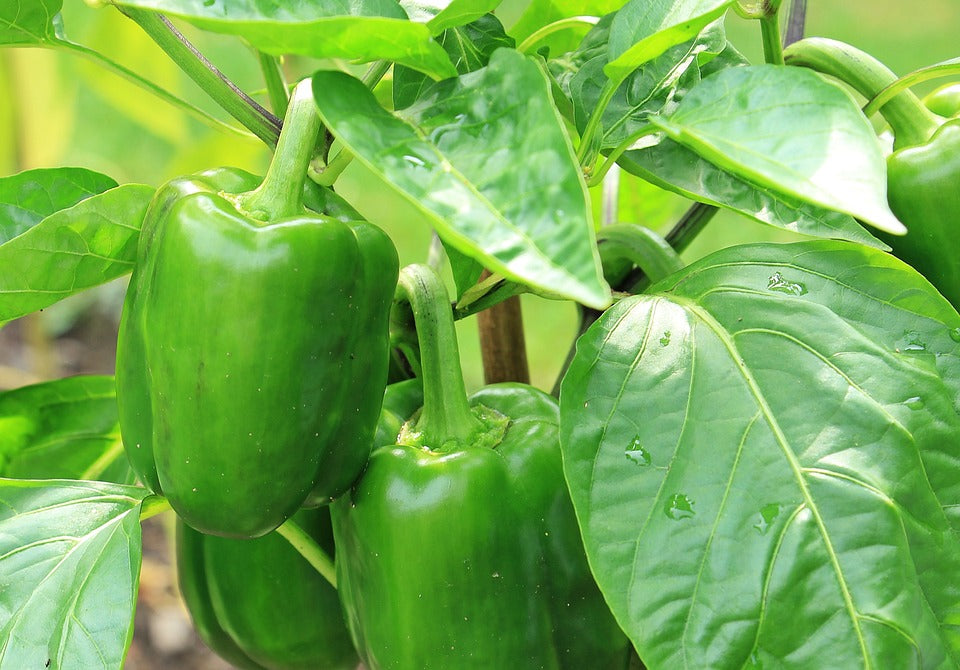By Michael Jenkins

Bell peppers (the larger, sweeter varietals of Capsicum annuum) don’t get the attention that tomatoes or hot chilies do, and that’s a shame. Bell peppers are delicious, versatile veggies and the plants that produce them are quite lovely indeed. Growing bell peppers at home is a wonderful addition to the garden, complimenting many other garden vegetables like tomatoes, cucumbers, and salad greens. And as it turns out, growing your own bells isn’t particularly difficult with a little knowledge and preparation. So, in grand Gardzen fashion, let’s dig in and learn about growing the best bell peppers at home.
Let’s start with soil and growing conditions, as these are the foundations for a successful bell pepper harvest later on. Bell peppers require warm, sunny conditions—six to eight hours of sunlight a day. Seeds germinate best in temperatures around 75F/24C, and the seedlings require similar temperatures to thrive. Seeds should be started indoors, and moved outside when nighttime temperatures are at least 65F/18C. Bell peppers like well-drained, loamy soil, and require deep, effective watering—1-2 inches/2.5-5cm of water a week depending on conditions. For gardeners just getting started with bells, a good rule of thumb is that they enjoy generally the same conditions that tomatoes do, so if you’ve done tomatoes successfully in the past, planting bell peppers in the same space with similar soil should get you started on the path to success.

Bell peppers are a beautiful addition to any garden
About spacing: bell pepper plants can get surprisingly large—from 18 inches /45cm to 3 feet/90cm tall and equally wide. Overcrowding bell pepper plants—or an nightshade like tomatoes, eggplant, or other peppers—can negatively affect the health of the plant and lead to problems with fungal infections, nutritional deficiencies, and lower productivity. Give your bell peppers plenty of space in the ground or in raised beds, and at least a five gallon container if you’re growing them indoors or on a patio.
Bell peppers are fairly easy when it comes to nutrition. They don’t need a lot of food—well composted soil and a bit of 5-10-10 fertilizer every now and then should keep them happy. Be careful not to give them too much nitrogen; this will lead to lush, green plants with beautiful foliage and no flowers or fruit. Likewise, a lack of calcium will lead to plenty of foliage and flowers and then blossom end rot. Blossom end rot can occur in tomatoes, eggplant, or peppers, and it happens when a lack of calcium leads to fruit that develops black or brown rot at the blossom end before ripening.

Bell peppers come in a stunning number of varieties and colors
There are a few other issues that can occur and prevent a full harvest from your bell peppers. Even healthy, fully grown bell pepper plants are sensitive to temperature, and prolonged exposure to temperatures over 90F/32C can lead to blossom drop, when flowers and even small fruit fall off the plant due to stress. Deep and effective water, deep mulching to protect the soil from heat and sun, and maybe some shade during the hotter parts of the day can help with this issue. Troubleshooting your pepper plants will definitely be the subject of an upcoming blog, so stay tuned as we move through the growing season!
If you’re new to bell peppers, we hope this blog helps you get started. If you’re an experienced gardener, we hope you found a few useful tips here. As always we love hearing from you, so if you have tips or tricks for growing bell peppers and you’d like to share them, get in touch!

Leave a comment